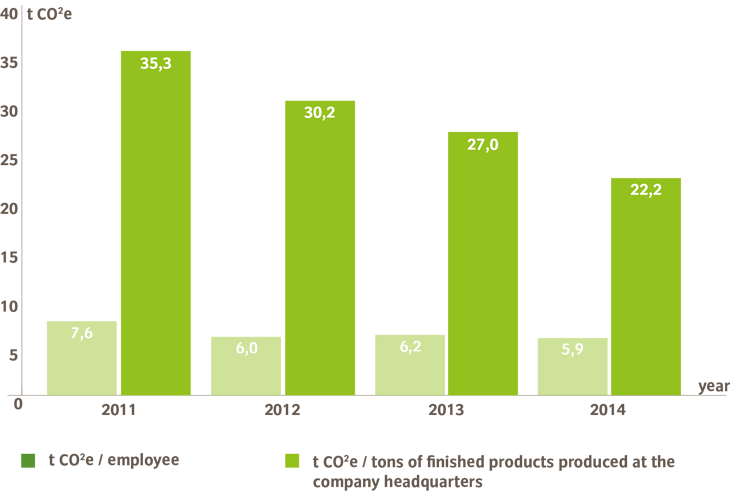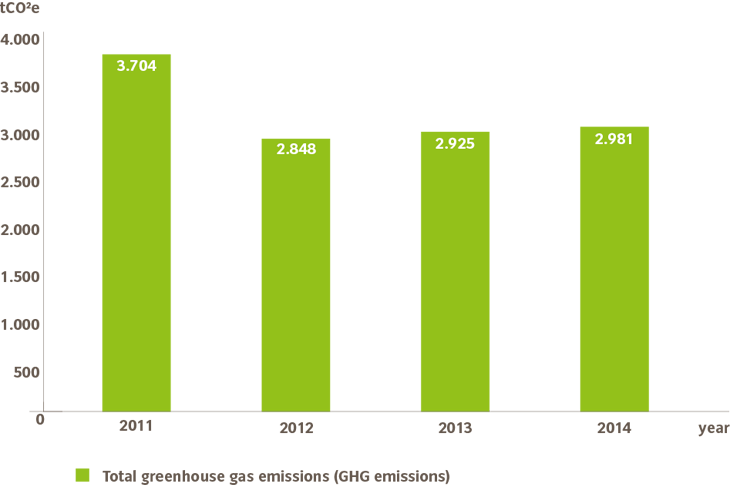
Climate-neutrality at the company headquarters in Tettnang
20% less emissions since 2011
Every commercial activity that is based on the combustion and processing of fossil fuels causes greenhouse gas emissions (GHG emissions) and thus contributes to climate change. This greenhouse effect leads to a shift of the earth's climate and threatens man and nature in various regions of the world in many ways.
Climate-neutral production in Tettnang
Since 2011, VAUDE has been creating and publishing an annual corporate carbon footprint for its headquarters in Tettnang. Since 2012, this entire site and all products manufactured there have been climate neutral.
After eight years of environmental management, our database is comprehensive. We have identified our most important emission polluters, and we have already achieved significant emission reductions at this site by implementing a variety of projects, both large and small.

|
»Climate neutrality is an important component in our overall commitment to sustainability. With the carbon footprint, we can recognize our reduction potential. « Dr. Antje von Dewitz / CEO
|
Emissions per employee and per ton of products made at the company headquarters

Complete climate balance since 2011
We used comprehensive data on consumption for our site in Tettnang to calculate a solid climate balance. The outcome is that we have reduced emissions at the Tettnang site by 20 percent since 2011.
Our management analyzes the results of the climate balance yearly to derive goals and measures for reducing emissions. One example of this is the goal that by the year 2015, we will reduce emissions from commuting by 10 percent compared to 2011.
The steps to climate neutrality
The most important step is the reduction of consumption and thus emissions.

To reduce emissions, all consumption must be first detected and measured to the greatest extent possible. By reducing this consumption, a reduction of harmful emissions can be achieved.
Emission measured in CO2e
The unit used to measure emissions is CO2e: "carbon dioxide equivalents". In the calculation of the carbon footprint, not only all the upstream and downstream processes, but also all other greenhouse gases such as methane are included in carbon dioxide.
Overview of emissions

Overall, emissions have increased by 2 percent compared to 2013. This is particularly due to the higher transport volumes and more employees that use more consumables - from office paper about computers, printers and toilet paper.
We are especially encouraged by the reduction of emissions from energy consumption. This has been achieved primarily by switching to biogas .
For detailed figures about emissions at the VAUDE headquarters in Tettnang-Obereisenbach, see "Greenhouse gas emissions in detail".
More information:
Total quantity of emissions

Compensation with “Gold Standard”
All unavoidable emissions at the headquarters in Tettnang have been offset by a compensatory payment to a Gold Standard certified carbon offset project by the non-profit myclimate organization.
See a film about the project:

|
How carbon compensation works:
“Unavoidable emissions are offset lsewhere by projects that reduce emissions. The balance of emissions is therefore neutral.” |
Project in China for CO2 reduction is supported
The project involves replacing coal consumption from traditional coal burning stoves with improved clean biomass (from corn waste) burning semi-gasifier stoves in rural households. While cleaner-burning petroleum-based fuels are increasingly common in wealthier areas, at least 50 percent of all households still depend on solid fuels like wood or coal as an important household fuel.
Burning solid fuels leads to air pollution and is responsible for over 450,000 deaths annually in China alone. By substituting coal fuel with biomass, it is possible to not only reduce CO2 emissions, but also improve indoor air quality, directly benefiting the health of the families.
More information about the project here and in our film:
Our long-term goal is to systematically expand the climate neutrality of the company to our other production facilities as well. Until now we have too little data about energy consumption and upstream and downstream processes from our supply chain to be able to create a carbon footprint.
Source of emissions
Greenhouse gases such as CO2 are generated at VAUDE by electrical, gas and other fuel energy consumption, by the use of materials for the production of waterproof bags and backpacks, and also from paper consumption, office supplies, data processing and packing materials.
Also included are all wastes generated on site, all business trips, the daily commutes of our employees and all logistics including the transportation of all materials and products in production in Tettnang and from there to all retail and distribution partners.
Three “scopes” for emissions
In the determination of emissions, there are three areas (scopes) in which emissions can arise from activities of a company.

Insufficient data from our supply chain
VAUDE’s emissions do not only come from the company headquarters in Tettnang. In VAUDE’s upstream supply chain, emissions occur due to the amount of products manufactured, the amount we estimate to be many times higher than emissions at our Tettnang headquarters. We have no consumption data from the supply chain that we can use to calculate a carbon footprint. An exception is the transport for delivery of the goods to the warehouse in Tettnang: see Emissions in detail.
| GRI: | EN18 |
| GRI: | EN19 |
| GRI: | DMA Emissions |




